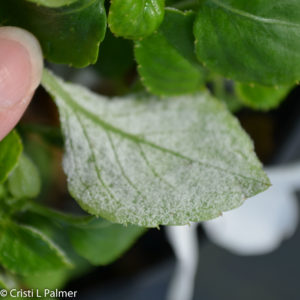
In 2008, IR-4 initiated a high priority project to determine efficacy of several fungicides on downy mildew pathogens so data can be obtained to support current and future registrations. This research was conducted in 2008 and in 2009. Subsequently, Impatiens Downy Mildew (IDM) emerged, and studies on this disease sponsored in part by USDA-APHIS occurred from 2013 through to 2016. In addition to research collected from 12 studies through the IR-4 program from 2008 to 2016, this summary includes a review of 38 experiments conducted from 2000 to 2014 on ornamental horticulture crops. During this time period, numerous products representing 41 active ingredients were tested as foliar or drench applications against several species causing downy mildew on ornamentals. Most products are registered and commercially used. Most tests were conducted on Plasmopara obducens (impatiens downy mildew); other species tested included Peronospora lamii (lamium downy mildew), Peronospora sp.(coleus downy mildew), Peronospora sparsa (rose downy mildew), Peronospora statices (limonium downy mildew), Peronospora antirrhini (snapdragon downy mildew),and Plasmopara viburni (viburnum downy mildew). Although there were insufficient data for definitive conclusions, five relatively new products provided efficacy. Adorn (V-10161) was effective for impatiens initially, lamium and snapdragon downy mildews. Orvego (BAS 651F) provided good to excellent control of coleus, impatiens, lamium and snapdragon downy mildews. Micora (NOA 446510) provided good to excellent control of coleus, impatiens, lamium and snapdragon downy mildews. Regalia exhibited excellent control of impatiens downy mildew, and good control of lamium, snapdragon and viburnum downy mildews at the higher rate. Segovis applied as a drench provided excellent control of impatiens downy mildew.
Basil downy mildew, caused by Peronospora belbahrii, has become a major problem in the production of basil in the United States since it was first reported in south Florida in 2007. We reviewed 31 available trials published in Plant Disease Management Reports to check efficacy of experimental and registered fungicides on basil downy mildew. Generally, Revus (mandipropamid), Quadris/Amistar (azoxystrobin), and Reason (fenamidone) applied as sprays, and Ridomil Gold (mefenoxam) drench or spray provided good to excellent efficacy. Efficacy of Ranman (cyazofamid) spray was variable. Two new products Zorvec/QGU42 (oxathiopiprolin) and Zampro/BAS 651 (ametoctradin + dimethomorph also provided excellent efficacy. The phosphorus acid fungicides (including Agri-Fos, K-Phite, Nutri-Phyte, Phostrol, Prophyt) and the products for organic production, including biofungicides (Actinovate, Companion, Double Nickel, Regalia,Serenade, Sonata), and copper fungicides (Badge X2, Cueva, Kocide, Nordox, Nu-Cop) generally provided poor efficacy.


